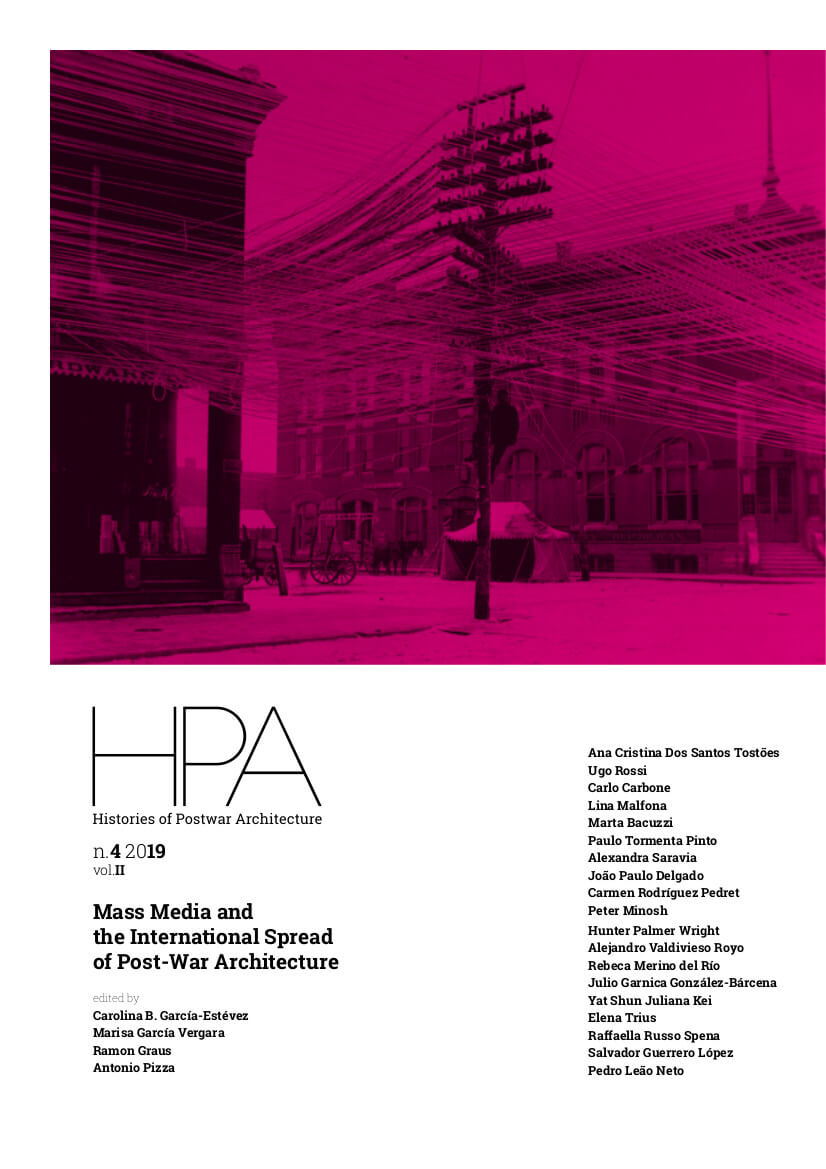The Story of Another Idea: Forum voor Architectuur en Daarmee Verbonden Kunsten’s. Construction of Netherlander Contemporary Urban Landscape
DOI:
https://doi.org/10.6092/issn.2611-0075/9619Keywords:
Forum voor Architectuur en Daarmee Verbonden Kunsten, The Netherlands, Aldo van Eyck, Jaap Bakema, Contemporary CityAbstract
“The Story of Another Idea” is the title provided to the first and the last issues of Forum voor Architectuur en Daarmee Verbonden Kunsten edited by the Dutch representatives of Team 10. From 1959 to 1967, Forum journal was the media employed by Aldo van Eyck and Jaap Bakema to spread not only the ideas shared during Team 10’s meetings but also their own research. The editorial board was comprised by other architects, like Herman Hertzberger or Joop Hardy, who developed outstanding careers afterwards. Despite the manifold authorships and formats, there is a common thread underlying all Forum’s contributions: the criticism of the functional city and the definition of an alternative urban model based on human relationships. The deliberate selection of the word ‘landscape’ for the title intends to narrow the focus on the visual component of urban design, which will be a distinctive feature of their theoretical investigations and more idealistic proposals. Forum’s issues published in this period are dissected by isolating those entries considered essential to reconstruct the evolution of the editors’ critical discourse on the construction of contemporary city mainly as a reaction against the functionalist approach encouraged by outstanding members of CIAM years before.
This article aims at shedding light on the importance given by Dutch Team 10 to habitat configuration and visual composition in the design of contemporary city after the Second World War and the establishment of the Welfare State in the 1950s. The chronological ordering of selected contributions to Forum since 1959 until 1967, helps us to identify the changes in the editors’ research on urban design, as well as to contextualize it in the post-war social, political, and cultural framework. To conclude, this study intends to demonstrate in which way Forum’s content contributed to characterize an alternative Dutch Post-War urban landscape.
Downloads
References
Bakema, Jaap. “Schindler’s Spel Met de Ruimte.” Forum voor Architectuur en Daarmee Verbonden Kunsten 15, n. 8 (1960-1): 253-263.
Bakema, Jaap. “Otterlo 1959 - 1962.” Forum voor Architectuur en Daarmee Verbonden Kunsten 16, n. 2 (1962): 74.
Bakema, Jaap. “Von Schwelle bis Stadt.” Forum voor Architectuur en Daarmee Verbonden Kunsten 16, n. 4 (1962): 123-130.
Bakema, Jaap. “Architectuur als Instrument in het Menselijk Bewustwordingsproces.” Forum voor Architectuur en Daarmee Verbonden Kunsten 17, n. 2 (1963): 53-79.
Bakema, Jaap. “Het Beeld van Totale Verstedelijking.” Forum voor Architectuur en Daarmee Verbonden Kunsten 17, n. 4 (1967): 83-84.
Coverley, Merlin. Psychogeography. Harpenden: Pocket, 2010.
Eyck, Aldo van. “Editorial,” Forum voor Architectuur en Daarmee Verbonden Kunsten 15¸ n. 3 (1960-1): 107-112.
Eyck, Aldo van. “Kindertehuis in Amsterdam.” Forum voor Architectuur en Daarmee Verbonden Kunsten 15, n. 6-7 (1960-1): 196-235.
Eyck, Aldo van. “Editorial.” Forum voor Architectuur en Daarmee Verbonden Kunsten 17, n. 3 (1963): 97-98.
Eyck, Aldo van. “Editorial.” Forum voor Architectuur en Daarmee Verbonden Kunsten 17, n. 4 (1967): 51.
Eyck, Aldo van, Vincent Ligtelijn, and Francis Strauven. Aldo van Eyck: Writings. Amsterdam: SUN, 2008.
Grijalba Bengoetxea, Alberto, Rebeca Merino del Río, y Julio Grijalba Bengoetxea. “Representando el tiempo: polivalencia espacial en las viviendas Diagoon y Centraal Beheer.” EGA Expresión Gráfica Arquitectónica 24, n. 35 (2019): 168-181.
Hertzberger, Herman. “Editorial.” Forum voor Architectuur en Daarmee Verbonden Kunsten 15, n. 1 (1960-1).
Hertzberger, Herman. “Editorial.” Forum voor Architectuur en Daarmee Verbonden Kunsten 15, n. 5 (1960-1): 159-160.
Hertzberger, Herman. “Naar een Vertikale Woonbuurt.” Forum voor Architectuur en Daarmee Verbonden Kunsten 15, n. 8 (1960-1): 264-273.
Hertzberger, Herman. “Flexibiliteit en Polyvalentie.” Forum voor Architectuur en Daarmee Verbonden Kunsten 16, n. 3 (1962): 115-121.
Hertzberger, Herman. “Identiteit.” Forum voor Architectuur en Daarmee Verbonden Kunsten 17, n. 4 (1967): 17-18.
Heuvel, Dirk van den. “The Kasbah of Suburbia.” AA files, n. 62 (2011): 82-89.
Heuvel, Dirk van den, Piet Blom, Francis Strauven, Arjen Oosterman, Piet Vollaard, Joop Hardy, and Guus Beumer. “Structuralism: An Installation in Four Acts.” Volume (Amsterdam, Netherlands) 42, n. 4 (2014): 81-112.
Heuvel, Dirk van den, ed. Jaap Bakema and the Open Society. Archis: Amsterdam, 2018.
Merino, Rebeca, Julio Grijalba Bengoetxea, and Alberto Grijalba Bengoetxea. “Paisajes urbanos. El edificio como una ciudad. Centraal Beheer.” ZARCH Journal of Interdisciplinary Studies in Architecture and Urbanism 0, n. 7 (2016): 144-157.
Merino del Río, Rebeca, and Julio Grijalba Bengoetxea. “Centraal Beheer: los límites del estructuralismo en la configuración de un espacio-soporte.” Proyecto, Progreso, Arquitectura 0, n. 19 (2018): 36-55.
Merino del Río, Rebeca. “Entre la utopía y el idealismo: análisis de las correspondencias entre los modelos urbanos de Bakema y Constant para la ciudad del futuro.” Temporánea (in press).
Muller, Sheila D. Dutch Art: An Encyclopedia. New York-London: Routledge, 2011.
Risselada, Max, and Dirk van den Heuvel. Team 10. 1953-1981: In Search of a Utopia of the Present. Rotterdam: NAi Uitgevers, 2014.
Rouillard, Dominique. “Megaspace structure Yona Friedman and Eckhard Schulze-Fielitz.” Histories of Postwar Architecture 1, n. 3 (2018): 3-18.
Safdie, Moshe. “A Case for City Living.” Forum voor Architectuur en Daarmee Verbonden Kunsten 16, n. 5 (1962): 173-174.
Schindler, Rudolf M. “Reference Frames in Space.” Architect and Engineer 165, n. April (1946): 40-43.
Strauven, Francis. Aldo van Eyck: The Shape of Relativity. Amsterdam: Architectura & Natura, 1998.
Downloads
Published
How to Cite
Issue
Section
License
Copyright (c) 2019 Rebeca Merino del Río
The copyrights of all the texts on this journal belong to the respective authors without restrictions. Authors grant to the journal a non-exclusive right to publish their work.
This journal is licensed under a Creative Commons Attribution 4.0 International License (full legal code).
See also our Open Access Policy.






